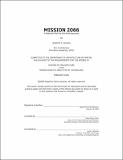| dc.contributor.advisor | Rania Ghosn. | en_US |
| dc.contributor.author | Jacques, Angeline C.(Angeline Claire) | en_US |
| dc.contributor.other | Massachusetts Institute of Technology. Department of Architecture. | en_US |
| dc.date.accessioned | 2021-02-19T20:25:36Z | |
| dc.date.available | 2021-02-19T20:25:36Z | |
| dc.date.copyright | 2020 | en_US |
| dc.date.issued | 2020 | en_US |
| dc.identifier.uri | https://hdl.handle.net/1721.1/129861 | |
| dc.description | Thesis: M. Arch., Massachusetts Institute of Technology, Department of Architecture, February, 2020 | en_US |
| dc.description | Cataloged from student-submitted thesis. Pages 68 and 69 blanks. | en_US |
| dc.description | Includes bibliographical references (pages 54-55). | en_US |
| dc.description.abstract | In 2020, facing the incontrovertible evidence that American protected lands are experiencing rapid climate change well above the national average, the National Park Service releases Mission 2066. The master plan acts as a critical foil to its centennial predecessor, Mission 66, which introduced a modernized highway system and architecture to match the automobile age of the mid-20th century. While M66 employed the viewing station, visitor center, and postcard to render protected landscapes as a visitable object of American identity/heritage, M2066 seeks new strategies that react to and augment ecological systems and actors. It accepts the Anthropocenic assumption that truly untouched wilderness is an obsolete concept and is rooted, in the United States, in American expansionism and nationalism.The site of this thesis is Glacier National Park in Montana, paradoxically named as one of the last bastions of pristine wilderness in the United States as well as the poster child for cataclysmic climate change. Its namesake glaciers have dwindled from 150 a century ago to only 26 today, all of which are predicted to go extinct this century. In M2066, park stewards take a more active role in maintaining the glacier population in the park, as they have historically done to avoid extinction with Gray Wolf and American Bison populations. They adapt and deploy a series of interventions that augment and artificialize melting glaciers. These interventions not only assist in easing the speed of change to ecologies and economies reliant on the glaciers but also provide new inhabitations of the park. | en_US |
| dc.description.statementofresponsibility | by Angeline C. Jacques. | en_US |
| dc.format.extent | 69 pages | en_US |
| dc.language.iso | eng | en_US |
| dc.publisher | Massachusetts Institute of Technology | en_US |
| dc.rights | MIT theses may be protected by copyright. Please reuse MIT thesis content according to the MIT Libraries Permissions Policy, which is available through the URL provided. | en_US |
| dc.rights.uri | http://dspace.mit.edu/handle/1721.1/7582 | en_US |
| dc.subject | Architecture. | en_US |
| dc.title | MISSION 2066 : a national park for the Antrhopocene | en_US |
| dc.title.alternative | National park for the Antrhopocene | en_US |
| dc.type | Thesis | en_US |
| dc.description.degree | M. Arch. | en_US |
| dc.contributor.department | Massachusetts Institute of Technology. Department of Architecture | en_US |
| dc.identifier.oclc | 1236893778 | en_US |
| dc.description.collection | M.Arch. Massachusetts Institute of Technology, Department of Architecture | en_US |
| dspace.imported | 2021-02-19T20:25:05Z | en_US |
| mit.thesis.degree | Master | en_US |
| mit.thesis.department | Arch | en_US |
